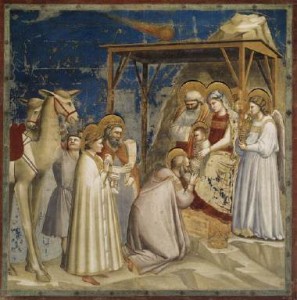
03 May GIOTTO’S FRESCOES: TECHNIQUE AND SOLUTIONS
As a finishing touch to a fresco, we talk about “tempera a secco” or the use of lime, in other words, a fresh medium; even the veils of glaze applied at the end of the working day can contain organic binders. This composite technique (lime and organic tempera) is used on the “pontate” (the so-called day’s work) where pure carbonisation was only a base of the work. With the “giornate” technique, the auxiliary tempera was put to one side, but not completely abandoned. Auxiliary tempera was used by Giotto, Simone Martini, Ambrogio Lorenzetti, etc.
It is not easy to identify on first sight a pure fresco from one painted using the “secco” technique, even more so if time has consumed and levelled the chromatic surfaces, but a careful examination of the density of the layers and their behaviour over time allows us to understand many things. An example is Giotto’s fresco in the Bardi chapel: the Church of St Croce in Florence, where St Chiara’s clothes were formed using auxiliary tempera on top of a frescoed outline.
An explanation for this comes from the fact that the extensive laying of the plaster, which took in the entire image, required more working time than that available for true fresco painting. For this reason, Giotto resorted to using an auxiliary for continuing the work in the following days.
The Scrovegni Chapel in Padua contains Giotto’s “The Mission of Gabriel” which uses auxiliary tempera. Due to water infiltrations and relative contaminations, what we notice is the total loss of the secco tempera and the partial loss of the clothes painted with auxiliary tempera, while the “buono fresco” (true fresco) remains reasonably well intact on the heads and hands and outlines.
Giotto created his frescoes based on his complete knowledge of the “lime” material and its carbonisation process. The most resistant was the buono fresco, followed by the auxiliary tempera obtained with the addition of milk or casein. Once the plaster was dry, the painting was completed “a secco” with the colours that could not resist the alkali environment of fresh lime-based plaster such as blue, copper green, red lead, lake red, and binders with egg or pigment glue.
In the end, the painting was embellished with metals in leaf: tin, golden tin, gold, resin and oil. These techniques had varying degrees of resistance: the most resistant was the shiny stucco and the fresco paint, while the auxiliary tempera was less resistant. The egg and glue-based tempera was very vulnerable in damp areas and very weak in the dry parts. The gold was well preserved, while the golden tin has darkened without losing its hold.





No Comments